Main Spotlight: Connecting, Innovating, and Sustaining a Healthy Main Street Movement
Key takeaways from six sessions at the 2025 Main Street Now Conference.

Marion, Iowa © Tasha Sams
We work in collaboration with thousands of local partners and grassroots leaders across the nation who share our commitment to advancing shared prosperity, creating resilient economies, and improving quality of life.

Emporia, Kansas © Emporia Main Street
Made up of small towns, mid-sized communities, and urban commercial districts, the thousands of organizations, individuals, volunteers, and local leaders that make up Main Street America™ represent the broad diversity that makes this country so unique.

Chicago, Illinois © Main Street America
Looking for strategies and tools to support you in your work? Delve into the Main Street Resource Center and explore a wide range of resources including our extensive Knowledge Hub, professional development opportunities, field service offerings, advocacy support, and more!

Waterloo, Iowa © Main Street Waterloo
Your one-stop-shop for all the latest stories, news, events, and opportunities – including grants and funding programs – across Main Street.

Kendall Whittier — Tulsa, Oklahoma © Kendall Whittier Main Street
Join us in our work to advance shared prosperity, create strong economies, and improve quality of life in downtowns and neighborhood commercial districts.
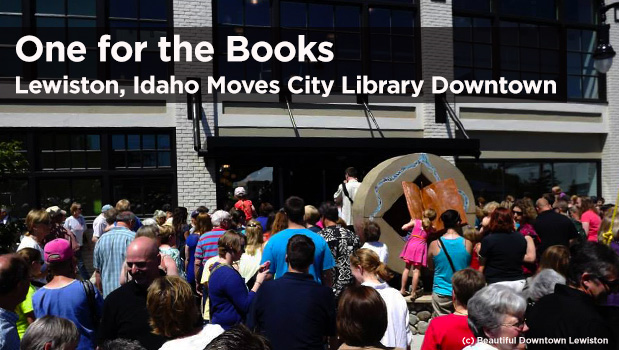
Over 1,000 people awaiting entrance to the library following the ribbon cutting on June 8, 2013.
I still get chills thinking about June 8, 2013, the day that more than one thousand people gathered downtown to celebrate the Lewiston City Library’s grand re-opening at 411 D Street. If you’ve ever been part of something that was years (even decades) in the making, met and exceeded all expectations, and brought people together through a common vision, you are fortunate enough to know that feeling of shared joy and triumph. As speeches were concluded, the ribbon cut, and the doors were open to the public for the first time, people’s enthusiasm was evident through their exclamations and even tears as they toured the marvelous facility. Our community finally had the library it deserved.
Since 1977, the Lewiston City Library sat on the edge of town on a busy street, connected to a bar called The Wooden Nickel. It was only meant to be temporary space, but it wasn’t until 1999 that Lewiston took the first step to move to a larger building, one better suited to hold its collections and growing demand for new technologies and community programs.
Over the course of the next decade, a library strategic plan was completed and the Lewiston Library Foundation was created to raise funds. With strong community support, the Library Foundation was able to raise over $1.2 million dollars in private donations. In 2007, the Foundation and the city council made a five-year deal in which the council agreed to set aside $200,000 each year if the foundation was able to match it. By 2010 the Library Foundation had enough money to begin looking at locations.
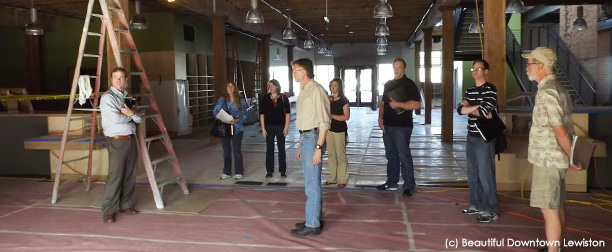
Architect Larry Kom and library director Alexa Eccles give Beautiful Downtown Lewiston board of directors a tour of the building.
Understanding the benefits of locating community facilities downtown, Beautiful Downtown Lewiston made a proposal that the library consider 411 D Street, a 50,000 square foot brick building located just a block from Main Street. After a feasibility study determined that the building was a viable option, the library board, staff, and foundation ramped up their campaign to make the downtown library a reality.
The library’s proposed move to downtown quickly became a community-wide debate.
Beautiful Downtown Lewiston had only been operating for two years, and Lewiston still remembered failed attempts at downtown revitalization in decades past. We were in the beginning stages of implementing the Main Street Four Point Approach and the community-at-large had yet to notice substantial changes. The vacancy rate was high, special events had yet to create enthusiastic followings and the number of blighted structures vastly outweighed rehabilitation projects. The library proposal was deeply tied to our community’s hope, or lack thereof, in downtown’s future.
City council meetings in early 2011 were dominated by the decision on whether or not to purchase 411 D Street. A survey of downtown stakeholders had identified moving the library downtown as a high priority for public funding. Beautiful Downtown Lewiston represented this interest by speaking at city council meetings that spring. At each meeting, we were alongside dozens of citizens who spoke passionately for or against the move. Opponents listed concerns ranging from specific issues like parking to a general disapproval of the city spending public funds on updating the library.
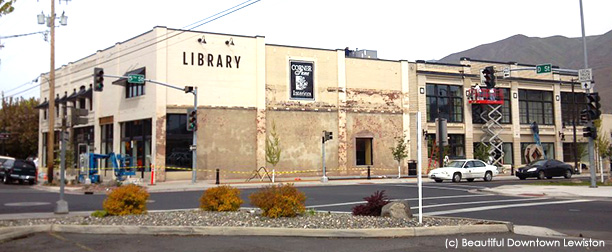
Exterior image of 411 D Street under renovation in downtown Lewiston.
We made the case that locating the library downtown would be the most convenient and safe location for the entire community. Located along public transit routes, just two blocks away from our river trail system, and close to major institutions like the college and hospital, it was easily accessible and in close proximity to other destinations. Furthermore, a library study found that the neighborhood with the highest percentage of library users was actually our historic Normal Hill neighborhood, which is adjacent to downtown. Upper floor residential use was increasing along Main Street and included the recent addition of a large dorm that housed over 100 college students. Beautiful Downtown Lewiston shared this information both with city council and with our own network, via our newsletter and social media sites, in an effort to educate and help dispel opposition to the library’s proposed move.
The library board, staff and foundation worked around the clock to build support for the new downtown library, and on April 25, 2011, following a more than three hour meeting, the city council voted to purchase 411 D Street for the Lewiston City Library.

The building price tag was $800,000 but the city was able to purchase it for $595,000 because of the generosity of the current owner, Bennett Industries, who donated the remaining $205,000. This is just one example of many private donations from local community members that made the new library possible. To date, the Lewiston Library Foundation has raised over $2,500,000 from close to 900 individual and business donors.
The foundation’s approach to fundraising was multi-faceted. Major gifts were sought through building long-term relationships. The foundation’s annual gala is successful due to a dedicated board of directors and a careful database of past supporters. They created programs such as First Edition Friend to capture smaller donations, which allows community members to sponsor a colorfully painted book. The foundation also promotes online shopping sites, like Amazon and GoodSearch, where a percentage of each purchase goes to the non-profit of your choice.
From Bolts to Books
A local firm, Castellaw Kom Architects, was hired in 2012 to renovate the historic building, which had been constructed and subsequently remodeled over the last 120 years. Erb Hardware occupied the space from the early 1900s until the 1980s when Cornerstone Interiors began occupying the space. Both the hardware store and the interior design business were owned by members of the Bennett family, which later donated a portion of the building sale to the library.
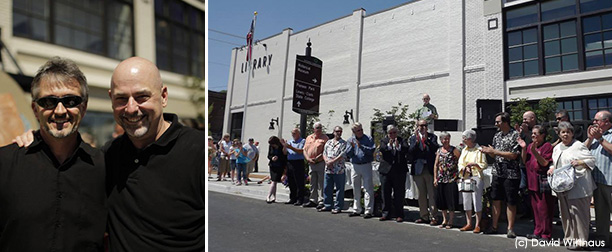
Left: Architects Larry Kom and Greg Castellaw Right: Lewiston City Library staff, board members, city councilors, and Library Foundation members
A major street rebuild of Fifth Street, which is immediately adjacent to 411 D Street and an important entryway to downtown, was occurring at the same time as the renovation. Both a challenge and an opportunity for the library renovation, Lewiston’s Urban Renewal Agency and Lewiston City Library worked together to coordinate the street rebuild and the library renovation. Beautiful Downtown Lewiston’s Design Committee was also asked to contribute streetscape recommendations to the URA, and then to coordinate and select significant number of public art pieces that were folded into the street rebuild. A library focal point fountain was commissioned by Lewiston-native Peter Goetzinger, and complimentary benches were designed by his wife Kelly Price.
The library was awarded a local Orchid Award in 2014 for Excellence in Historic Preservation and has also received statewide recognition for its outstanding renovation. Existing brick interior walls were cleaned and brought to new life; tongue and groove ceilings found during demolition were repaired; steel columns and beams were cleaned, exposed and repainted; and fir flooring was uncovered, cleaned, repaired, and refinished with great success. Castellaw Kom Architects took great care to reuse and repurpose wherever possible. In addition to serving our community as a highly functional space for the public library, the building is now an undeniable gem in our historic downtown.
The Library Our Community Deserves
The library has been able to expand staffing, programs, technology and available collections as a result of the move. The foundation is in the process of raising another $2,000,000 to be used for the second floor renovation, which will include a large meeting room, study, genealogy collection, roof garden, and more.
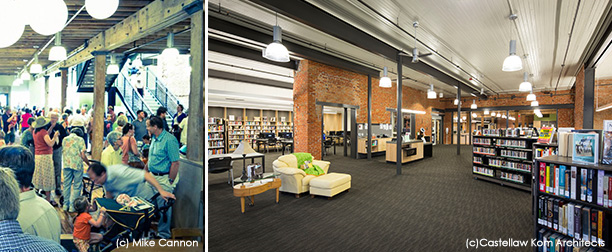
Left: Community members share the excitement of the new library at the grand opening celebration on June 8, 2013. Right: Finished renovation of the 1890 section of the building.
The numbers prove that the new building has benefited both the library and downtown Lewiston:
• The new library averages 13,000 visits per month, compared to an estimated 5,000 visits per month at the Thain Road location.
• The number of Registered Borrowers has increased by 85% in three years. New library users are at a record high.
• Average visit times at the library have grown from 15-30 minutes to two hours or more.
As a result of the thousands of people visiting the library each month, downtown cafes and shops are seeing more foot traffic and sales. Furthermore, it is an important example of public-private investment in downtown that we are using to recruit new businesses and residents to our community.
“Downtown Lewiston is blossoming, residents of Lewiston are proud of the library they worked 37 years to build,” says Alexa Eccles, Director of the Lewiston City Library. “The library’s renovation and move downtown is now widely held be the community as the most important and successful city project completed in the past 30 years.”
The downtown library is a destination for locals and visitors alike, an important partner in downtown’s growing cultural corridor, and a source of great community pride.
Breanne Durham has served as the executive director of Beautiful Downtown Lewiston since December 2010. Beautiful Downtown Lewiston is a 501c3 non-profit organization following the Main Street Approach to downtown revitalization.